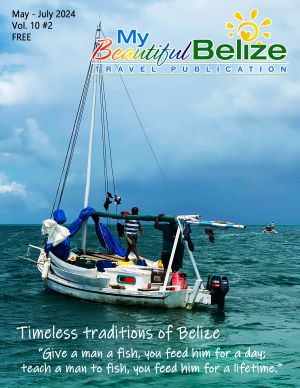Belize has amazing examples of sustainable forest practices. Some recent successful forest management initiatives have occurred within the Maya Forest Corridor (MFC). A combination of human resources, capacity-building, and research is used as a step forward to achieve sustainability in this landscape. For example, science researchers and biologists from several organizations have monitored jaguars in the MFC using cameras and collaborated with students from universities in the United Kingdom and our very own University of Belize.
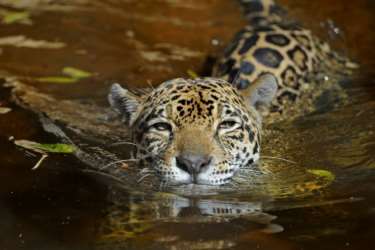
Jaguars are very good swimmers. (Photo ©J.Larsen Mahler/WCS
The jaguar is an iconic species in Belize, a member of the Big Cat Panthera family (tiger, lion, jaguar, leopard, and snow leopard), and one of five wildcat species found in Belize (the other four are ocelot, jaguarundi, margay, and puma). Over the years, there have been increased incidents of human wildlife conflict caused mostly by deforestation and overhunting, especially in buffering communities of the MFC. The Maya Forest Corridor is important to maintaining the jaguar population because it provides connectivity to the Selva Maya that spans Mexico, Guatemala, and Belize, and one of Mesoamerica’s Great Forests.
Through a special partnership between Panthera1 and University of Belize Environmental Research Institute, researchers learned how to carry out field assessments and monitor wildlife. These research initiatives resulted in the capture of the very first jaguar at the “Tapir Camp” at Cox Lagoon, within the MFC in 2012. The jaguar had been previously caught by the Runaway Creek crew and well-known scientists and former sustainable development minister, Dr. Omar Figueroa. WCS’s Conservation Ranger at the MFC, Michael Brakeman, who was part of the trapping team over a decade ago says, “The researchers were able to take blood samples and change the [tracking] collar that monitored this jaguar’s location before releasing it back into the wild.” He noted that, “These types of collaborative works have helped us to identify important wildlife that still live in this newly protected area. I am proud to be part of the team leading the continued preservation of this area in Belize, an important part to keeping our forest intact for my children’s future.”
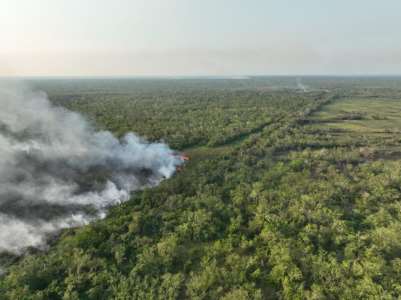
Evidence of a fire inside the Maya Forest Corridor. (Photo ©WCS)
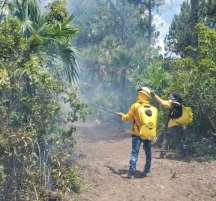
Rangers fighting fire inside the MFC. (Photo ©WCS)
Another example of collaboration using human resources, research, and capacity-building is the work that the Maya Forest Corridor Fire Working Group has been doing during the 2023 fire season. This is a group of committed and hard-working representatives from Monkey Bay Wildlife Sanctuary, Foundation for Wildlife Conservation, the Belize Zoo and Tropical Education Center, members of MFC buffer communities, and WCS (Wildlife Conservation Society). Recently, the group conducted a prescribed burn to reduce the fuel load within the MFC. With co-funding from the European Union (EU-Desira), the United States Fish and Wildlife Service (USFWS), and Whitley Fund for Nature (WFN), WCS has helped control and suppress at least five fires in the area since March 2023. MFC Site Manager at WCS, Yahaira Urbina explained that “Community involvement is key for management. The Belize Zoo spearheaded the initial establishment of the MFC Fire Working Group, through a CARSI grant from the US Embassy that focused on fire management and human health.
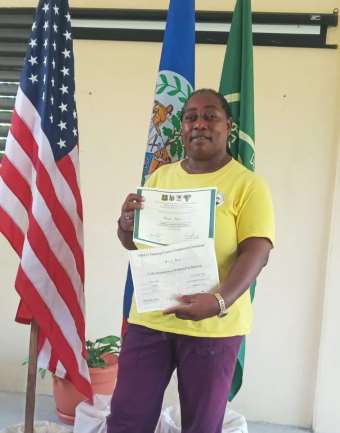
Ms. Raquel Vega is now certified as a wildland firefighter.
This effort has resulted in the formation of a coalition involving communities such Mahogany Heights, Frank’s Eddy, and La Democracia villages, and the managers of properties in the MFC. The aim of the program is to increase their knowledge of fire management and wildland firefighting capacity.”
The European Union (EU) facilitates continued training with community members like the Vice Chairperson and former Chairlady of Mahogany Heights, Ms. Raquel Vega, to build capacity to manage wildfires in their areas. Ms. Vega says the training will help her to educate her community. “I gain the experience to pass on to them that whenever there is a fire, together we can assist until help arrives.” She further explains that “Here in Mahogany Heights, WCS is engaged with the community. The children are educated in birdwatching and learn about the Maya Forest Corridor and how to protect it. WCS also does family events that involve the parents.”
The EU says it is “committed to climate action and assisting Belize in the sustainable use of its natural resources, protecting biodiversity, and fighting deforestation. Reducing fires and ensuring human and biodiversity health is one of many areas of EU interest.” By funding fire-management training for first responders, monitoring patrols for early detection of fires and fire-fighting operations, the organization is accomplishing one of its goals to help protect Belize’s forests.
by Wildlife Conservation Society


